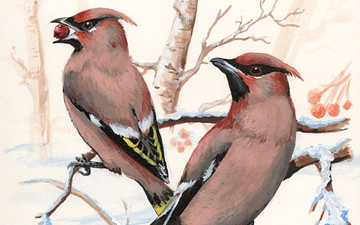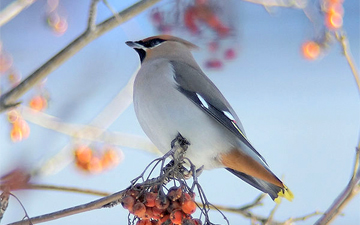The Bohemian Waxwing (Bombycilla garrulus) is a member of the waxwing family of passerines. A sleek bird, 18–21 cm long with a pointed crest, it travels in large, nomadic groups with a strong, direct flight. It breeds in coniferous forests throughout the most northern parts of Europe, Asia and western North America. As the Cedar Waxwing inhabits only North America and the Japanese Waxwing only Asia, the Bohemian Waxwing is the only member of this family whose range circumnavigates all the continents just below the sub-Arctic latitudes.
It is larger and greyer than the Cedar Waxwing and has bright yellow tips on its tail feathers and a yellow or white stripe along the wing feathers. Under tail coverts are a deep rust color. Both beak and feet are dark and the brown eyes are set in a narrow black mask underlined with white.
The call is a pleasant ringing sound, similar to that of the Cedar Waxwing but lower-pitched.
(From Wikipedia.org, August 2 2010)
– – –
Bohemian waxwings are described as Sturnus vulgaris-sized, having sleek crests, gray overall, with face washed in chestnut. The tip of the tail has a yellow band. Adult males have a throat patch that is larger than that of females and a broader yellow tip to the tail. The common name, “waxwing,” comes from the red waxy tips on their secondary feathers. A similar species, cedar waxwings (Bombycilla cedrorum), are smaller, having a pale yellow belly, and wings that are not as colorful. Juvenile Bohemian waxwings have plumage that is more gray than that of adults, with a whitish throat, and streaked underparts. (Alderfer, 2006; Tyne and Berger, 1976; Witmer, 2002)
(From Animal Diversity Web via The Encyclopedia of Life, August 2 2010)
– – –





